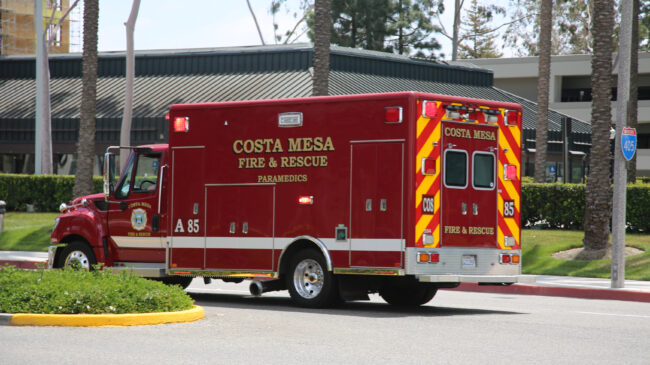Several of California’s local emergency medical services agencies have strongly advocated for what has been dubbed the fire “alliance” model to change how ambulance services operate. Attracting local officials with the lure of greater revenues, fire districts advocating for the alliance model are able to convince local emergency medical services agencies to cede their ambulance decision-making power to fire districts under no obligation to competitively bid contracts. Over time, this shift will likely harm performance, increase costs, and lead to fire districts acting as full emergency medical services agencies without any competitive threats.
The alliance model’s defining characteristic is the local emergency medical services (EMS) agency’s delegation of a local fire district to contract out ambulance services to private companies, instead of the EMS agency itself. When a local EMS agency contracts out ambulance service, they are required by the state to solicit contractors through a competitive bidding process where potential partners must submit proposals that undergo careful evaluation of pre-determined cost and quality factors. The process drives private providers to adhere to a preferred balance of quality and costs to appear as most attractive by a process that contains as little as subjectively possible.
Unlike EMS agencies, the fire districts seeking to implement the fire alliance model do not have to competitively bid their contracts for ambulance services. When a fire district is responsible for securing contracted services it transforms what has long been a robust public-private competitive process into a subcontracting decision more fit for ordering office supplies than choosing a provider to preserve care in the most vulnerable moments of many peoples’ lives.
But subcontracting without competition is merely a fig leaf for some fire districts’ long-term goals: running all aspects of EMS, including ambulance services, in a bubble which no competition can enter. Lured by promises of added revenues, local officials see the prospects of turning over ambulance services to fire districts as a win-win that offers more money and less hassle. But a competition-free EMS environment is more like a lose-lose that offers less transparency and potentially higher costs.
If there’s some truth in the positive revenue projections that fire districts make about the alliance model, it mostly stems from a pair of factors: fire districts’ access to grant monies, such as Ground Emergency Medical Transport (GEMT) programs, intergovernmental transfers (IGT), and the ability to use the lack of competitive bidding process to squeeze revenues from ambulance providers. By charging patients high rates, fire districts can keep much of the excess revenues, while effectively squeezing their alliance model partners by giving them as little as possible. In the alliance subcontracting model, the only way to receive the benefit of GEMT and IGT grant monies is by aligning with the fire district. But without a competitive bidding process, providers will be discouraged from participating.
California’s EMS regulatory agency, the Emergency Medical Services Authority (EMSA), recognized the alliance model’s anticompetitive nature from the onset. Contra Costa County’s EMS agency (CCCEMS) delegated ambulance contracting to the fire district in 2016, and while the fire district chose its subcontractor, CCCEMS attempted a farce of a competitive bidding process with the fire district and its preferred partner as the predetermined winner. Would-be competitors saw no point in participating in the attempt at open bidding made by the CCCEMS.
Despite the rejection, Contra Costa County currently operates under the alliance model. Other locales in California that have attempted the alliance model, are considering entering one, or have already entered one themselves include Alameda County, Chula Vista, and Santa Barbara County. The city of Oxnard is currently engaged in a legal dispute over the issue.
California Assembly Bill 389 would make the legal and regulatory concerns moot, by codifying the alliance model’s practice of contracting without competition, ensuring, over time, a diminished-to-nonexistent competitive landscape in ambulance services.
While the emergency medical services community writ large has long identified that a competitive bidding process is crucial to ensuring effective ambulance service contracts, fire protection districts, usually already part of the EMS equation as first responders before an ambulance can arrive for transport, see themselves as capable of managing the ambulance contracting decisions (and eventually, all ambulance service) without competitive bidding, or any competition. If fire districts really wanted to show they were capable, they would demonstrate that they could compete openly and transparently for the privilege of providing ambulance service, not find a backdoor loophole that allows them to make decisions of an EMS agency without being one while also using special tax treatment and grant privileges to keep an artificial competitive advantage over any meaningful competition.
Competition is vital in contracting decisions, especially for government entities. The private sector is willing to provide most “government” services on the right terms that work for taxpayers and the company. Competitive contracting invites innovative forces to improve the quality of services while weeding out opportunistic private entities capable of harming public finance and trust. Without competition, bad contracting decisions are more likely, and ambulance services are too vital to be delegated to subcontracting decisions where competition cannot enter the equation.
The alliance model not only removes any semblance of competition out of competitive bidding for ambulance service but also ensures that there will eventually be no competition for EMS in some California cities and counties. The lack of competition would ensure, over time, that costs will rise and quality will suffer. Before local governments and EMS agencies fall for fire district pleas to give them all the power over ambulance services without needed accountability, they should carefully consider the real short- and long-term implications for citizens.

